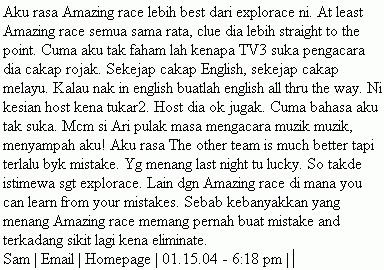 | ||
Bahasa Rojak (Malay for "mixed language") or Rojak language is a Malaysian pidgin (trade language) formed by code-switching among two or more of the many languages of Malaysia. The word rojak is taken from a local food of the same name.
Contents
History
Rojak language of Malaysia can be traced back to 1402, in the early Malacca of Parameswara, an international port where more than 80 languages from a variety of cultures were spoken. Worldwide traders, settlers, and original dwellers speaking multiple languages in a conversation was common.
According to the Encyclopedia of Malaysia (Languages and Literature), it is a contact language, specifically a pidgin, known in modern Malaysia as Rojak language. The uniqueness of Rojak language is in its code-switching style. A person who speaks Rojak language may begin with standard Malaysian, continue with English, then mix one or two words in Cantonese garnished with Tamil, and finish with Mandarin Chinese or some fashionable Japanese words. During Parameswara's time, when two groups of traders without a shared language met, they would try many possible languages in order to best understand each other, and the result would be a pidgin or Rojak.
In the early 16th century, Portuguese visitor Tome Pires found in Malacca
"Moors from Cairo, Mecca, Aden, Abyssinians, men of Kilwa, Malindi, Ormuz, Parsis, Rumi [Turks living abroad], Turks, Turkomans, Christian Armenians, Gujaratis, men of Chaul, Dabhol, Goa, of the kingdom of Deccan, Malabars and Klings, merchants from Orissa, Ceylon, Bengal, Arakan, Pegu, Siamese, men of Kedah, Malays, men of Penang, Patani, Cambodia, Champa, Cochin China, Chinese, men from Liu Kiu [Formosa] and Brunei, Luzonese, men of Tamjompura, Laue, Bangka, Lingga (and in this area 1000 more Islands are known), from the Moluccas, Banda, Bima, Timor, Madura, Java, Sunda, Palembang, Jambi, Tongkal, Indragiri, Kappatta, Menangkabau, Siak, Arcat, Aru, Bata, from the country of the Tomjano, Pase, Pedir, from the Maldives."
These peoples came to Malacca with junks, pangajavas, and ships, and by 1511, Malacca had a population of 50,000 people, including a resident trade community that spoke 84 languages.
The British brought in large numbers of immigrants from China and India from the late 18th to mid 20th century. The presence of local Malays, Orang Asli, Peranakans, Portuguese settlers, newly arrived Chinese and Indians, and others resulted in the wide use of mixed language.
Examples
Jangan lupa diri
"Do not forget your roots" or "Jangan lupa diri" is a rallying cry commonly heard among Malaysians interested in protecting their linguistic heritage. This statement suggests that, regardless of race, the Malaysian people have their own roots and ancestral origin to protect. In 2002, Tun Dr. Mahathir proposed that English be 'a tool' to obtain knowledge in the sciences and mathematics, as part of education in Malaysia.
Controversy
Bahasa Rojak is widely used, especially by Malaysian urban youths, which has triggered concerns about continued proficiency in the Malaysian and English languages being mixed, and consequent risks to job opportunities for new graduates. The Malaysian government is promoting the use of standard Malaysian, especially in the private sector, and discouraging the usage of Bahasa Rojak, similar to the Singapore Government's Speak Good English Movement and its discouragement of the use of the Singlish (Singaporean-English) pidgin. For example, Malaysian TV station TV3 in April 2006 changed the name of its carnival Karnival Sure Heboh to Karnival Jom Heboh as a result of this concern.
Comic magazines are often criticized for using Bahasa Rojak. Words or phrases written in Bahasa Rojak are often printed in boldface to enable readers to identify them. By the end of 2003, Gempak magazine began using a more formal language style and minimizing use of Bahasa Rojak, including the usage of bold lettering for words deemed colloquial.
